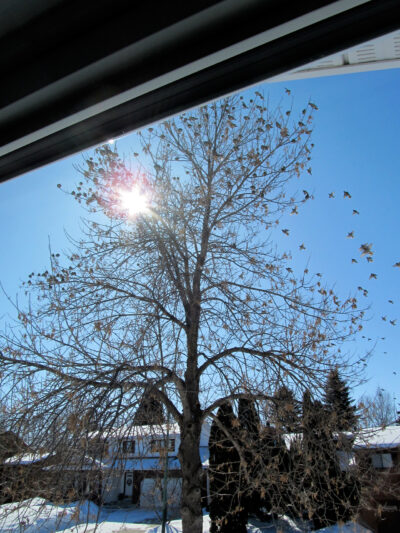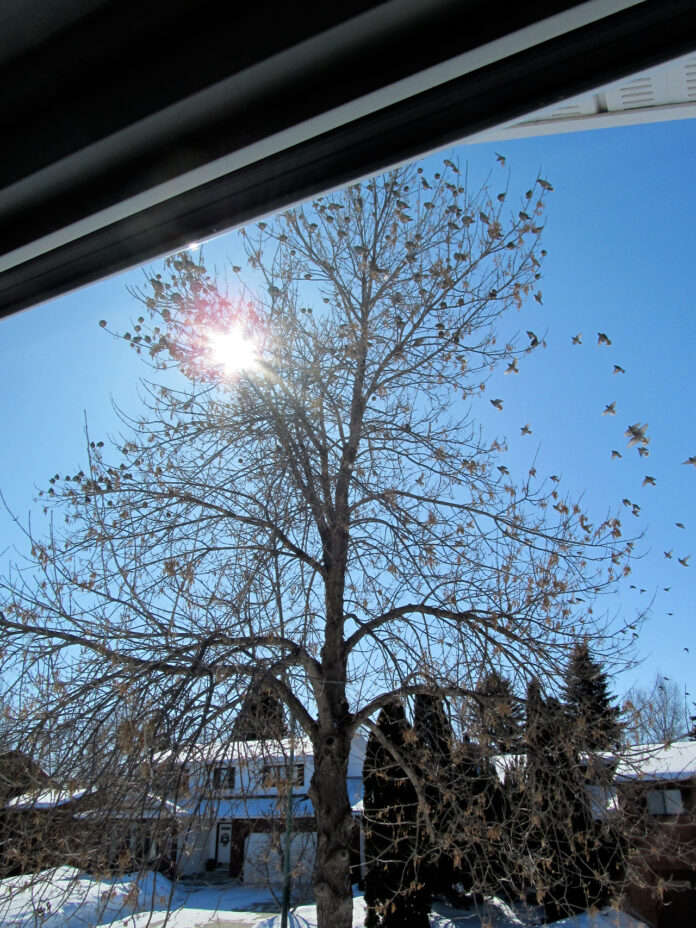BY HANNES THUM
 My students and I were suddenly distracted by something going on outside the room. A flock of Bohemian waxwings had landed in a tree, in perfect view of our windows along the creek and just 10 meters away, and was voraciously eating the tiny fruits that still hung on the branch tips this late in the winter.
My students and I were suddenly distracted by something going on outside the room. A flock of Bohemian waxwings had landed in a tree, in perfect view of our windows along the creek and just 10 meters away, and was voraciously eating the tiny fruits that still hung on the branch tips this late in the winter.
The birds, perhaps 30 or so of them, were leaping from branch to branch, scattering snow off the branches as they went. Individual birds hung upside down, craned their necks to reach tricky pieces of fruit, or spread their legs between two twigs in feats of acrobatics to get at the food. They were flashing and darting from place to place. The tree was vibrating.
The flock, working on the tree, was close enough that when one of my students got a little bit fidgety and bumped into the window, the birds startled. We could hear, through the glass, the percussive noise that the birds made as they flew away—the cumulative thunder of their wingbeats was much louder than expected—and the tree branches swayed as if they were being blown by a sudden wind gust.
They flew, as an uncannily synchronized group, and alighted on another tree downstream, immediately getting back to business. They tackled the new tree with the same vigor and speed as the first. We watched them for a long time. Long enough to watch them move from tree to tree, always in unison.
Here’s something interesting about flocking birds: ornithologists know that birds that move in flocks do not have a specific leader. It’s not like one of the birds in the flock is controlling when they leave a tree. No single bird is calling out “left turn!” or “fly up!” when they are in the air. No bird is calling the shots. Yet, they travel together and match one another’s movements with high precision.
There is a concept in science called “emergence.” The idea is that if you take some seemingly simple pieces and put a lot of them together, the resulting system develops its own behaviors. We can explain one bird, but entire flocks are harder.
Snowflakes are examples of emergent systems: chemists understand water molecules but they still can’t explain or predict exactly how they are going to align when frozen, which is why no two snowflakes are alike. Extreme weather events are emergent systems: we know what kinds of conditions tend to spawn hurricanes and tornadoes, but meteorologists can’t say with certainty when or where, exactly, they will occur. These systems are too complex, and they seem to have a mind of their own.
And so it is with flocking birds. How do birds, who have pretty small brains compared to other species, know when to turn left in flight, or right? How do they know when to land or when to eat? It’s pretty strange stuff.
Science loves to act like it is good at explaining things. But there’s a great deal that we do not know.



